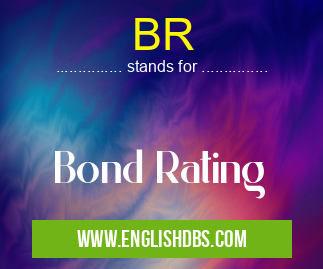What does BR mean in COUNCIL
BR stands for Bond Rating. It is a numerical or alphabetical grading assigned to bonds by credit rating agencies such as Standard & Poor's (S&P), Moody's, and Fitch Ratings. Bond ratings indicate the issuer's creditworthiness and the likelihood that they will be able to repay the debt on time.

BR meaning in Council in Governmental
BR mostly used in an acronym Council in Category Governmental that means Bond Rating
Shorthand: BR,
Full Form: Bond Rating
For more information of "Bond Rating", see the section below.
» Governmental » Council
Types of Bond Ratings
Bond ratings are typically divided into two categories:
-
Investment Grade: These ratings indicate a low risk of default and are typically assigned to bonds issued by governments, corporations, and other entities with strong financial positions.
-
Speculative Grade (Junk Bonds): These ratings indicate a higher risk of default and are typically assigned to bonds issued by companies with weaker financial positions or that are facing significant challenges.
Rating Scale
Each credit rating agency uses its own proprietary rating scale, but the general categories and their meanings are similar across agencies:
- AAA (S&P) / Aaa (Moody's): Highest rating, indicating extremely low risk of default.
- AA (S&P) / Aa (Moody's): Very high rating, indicating a very low risk of default.
- A (S&P) / A (Moody's): High rating, indicating a low risk of default.
- BBB (S&P) / Baa (Moody's): Medium-high rating, indicating a moderate risk of default.
- BB (S&P) / Ba (Moody's): Medium-low rating, indicating a significant risk of default.
- B (S&P) / B (Moody's): Speculative grade, indicating a high risk of default.
Factors Influencing Bond Ratings
Credit rating agencies consider numerous factors when assigning bond ratings, including:
- Issuer's financial strength and stability
- Issuer's industry and market conditions
- Debt-to-income ratio
- Interest coverage ratio
- Collateral securing the bond
Importance of Bond Ratings
Bond ratings are essential for investors because they provide valuable information about the risk and potential return of an investment. Higher-rated bonds typically have lower interest rates because they are considered less risky, while lower-rated bonds typically have higher interest rates due to the increased risk of default.
Essential Questions and Answers on Bond Rating in "GOVERNMENTAL»COUNCIL"
What is a Bond Rating?
A bond rating is an assessment of the creditworthiness of a bond or other fixed-income security. It is assigned by a credit rating agency and reflects the likelihood that the issuer will be able to make timely interest and principal payments.
Who Assigns Bond Ratings?
Bond ratings are primarily assigned by three major credit rating agencies: Standard & Poor's (S&P), Moody's Investors Service, and Fitch Ratings. These agencies use a set of established criteria to evaluate factors such as the issuer's financial health, industry conditions, and management.
What Do the Bond Rating Symbols Mean?
Bond ratings are typically expressed using letter symbols. The highest ratings represent the lowest risk of default, while the lowest ratings indicate a higher risk. The most common rating scales include:
- Investment Grade: AAA/Aaa (highest) to BBB/Baa (lowest)
- Non-Investment Grade (Speculative Grade): BB/Ba to D (default)
Why Are Bond Ratings Important?
Bond ratings provide investors with an indication of the risk associated with a particular investment. They can help investors make informed decisions about whether to buy, sell, or hold a bond, and can also influence the interest rates borrowers pay on their bonds.
Can Bond Ratings Change?
Yes, bond ratings can change over time. The rating agencies continuously monitor the financial health and performance of issuers and may adjust their ratings accordingly. Changes in ratings can impact the market value of the bonds and the issuer's ability to raise funds.
Final Words: BR (Bond Rating) is a critical element of the fixed-income market. It provides investors with a concise assessment of the issuer's creditworthiness and the risk associated with their bonds. By understanding bond ratings, investors can make informed decisions about their investments and manage their portfolio's risk-return profile effectively.
BR also stands for: |
|
| All stands for BR |
